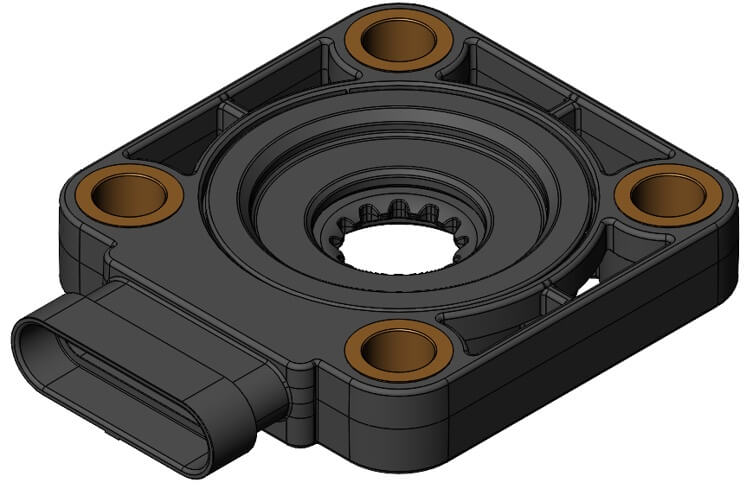
Electronic stability control (ESC), power steering and various advanced driver assistance systems (ADAS) rely on knowledge of steering wheel position, rate of turn and turn direction. This data comes from steering angle sensors mounted on the column. As safety-critical devices, vehicle manufacturers expect these to be both accurate and reliable. They also look for the smallest, lightest and least expensive package that does the job.
This need spurred Wells Engineered Products to recently adapt a new sensor technology – rotary position sensing – and apply it to measure steering angle, providing multiple advantages over the steering angle sensors used today.
Measuring Driver Intentions
How a driver turns the steering wheel conveys a lot of information about what they want the vehicle to do, especially when used in conjunction with wheel speed sensors. Low speed maneuvering for example often requires multiple turns executed quickly in both directions. The same movements performed at highway speeds imply the vehicle is moving in an uncontrolled manner.
Likewise, left and right wheels turning at different speeds with the steering pointing straight ahead indicates a lack of traction.
ESC and other safety systems take this data and compare it with what the vehicle is actually doing. Sophisticated algorithms then determine the corrective or remedial actions needed. This might include reducing engine speed and braking some or all wheels.
Steering angle sensors are safety-critical components where failure could lead to unpredictable consequences. To avoid such problems two, sometimes three sensors are used. This redundancy lets the vehicle systems check validity and detect any sensor problems. Discrepancies between sensors will result in ESC being disabled and a fault set.
Steering Angle Sensor Technology
Several different types of sensors are used in the steering column. Some have the column turn a small gear and measure how that moves. Others use Hall effect sensors or LED lights. Some sensors can only track rotation over a single turn and need an additional turn counter incorporating into the electronics while others can handle multiple turns.
Output is another differentiator. Both digital and analog outputs are available. Digital outputs may be passed directly into the CAN bus while analog signals ramp from 0 to +/-5V. (Typically, positive voltage signals clockwise wheel movement and negative counter-clockwise.)
Sensor Calibration
Steering angle sensors need calibration, both at installation and periodically throughout the life of the vehicle. The most common reason for calibration is following alignment of the front wheels. On some vehicles battery replacement can be enough for the sensors to need recalibrating. Omitting to do this will most often result in ESC being inoperable and a warning light coming on.
Sensor manufacturers provide various methods for performing calibration. Some must be carried out by a technician while others have automatic calibration routines built in. When selecting a steering angle sensor, it’s important to confirm which method of calibration is used.
The Wells Engineered Products Rotary Position Sensor
The new sensor developed by Wells Engineered Products is based on the principle of two-axis sinusoidal magnetization. Applicable wherever it’s essential to know shaft rotation speed and direction, the sensor comprises a magnet ring mounted on the shaft and a non-contact sensor. (For redundancy, a full steering column solution would use two sensors.)
Using changes in the magnetic field resulting from relative movement, the proprietary rotary position sensor provides two analog sine and cosine outputs. The interaction between the two gives ESC and other safety systems the steering wheel angle over multiple turns, plus rate of turn and turn direction.
Other outputs are available, including digital signals. The team at Wells Engineered Products works with customers to meet their requirements for connectors and interfaces.
Lamination-free construction improves durability and minimizes sensitivity to local magnetic fields. Sensor accuracy is 0.5° and tolerance to vibration, temperature extremes, dirt and moisture is higher than that of competing steering angle sensors. Calibration is straightforward and furthermore; the sensor is lighter and comes in a smaller form factor than the alternatives.
About Wells Engineered Products
Headquartered in Fond du Lac, Wisconsin, Wells Engineered Products specializes in the design and manufacture of high-quality electronic sensors and related devices for improved engine and vehicle performance, management and control. Sensing parameters such as flow, temperature and pressure, Wells products contribute to emissions and weight reduction, improved reliability, lower warranty claims and lower costs.
Heavy and sustained investment in manufacturing technology has resulted in highly automated operations with the flexibility to handle a wide range of volumes. Most importantly, automation supports predictable high quality by reducing the variability inherent in less sophisticated approaches to manufacturing.
A Collaborative Engineering Approach
Rather than creating a one-size fits all solution, our rotary position sensor is configurable for a wide range of installation methods and mounting locations. As with every Wells product, our engineering team works hand-in-hand with our customers to accommodate the needs and constraints of new or existing components and assemblies.
